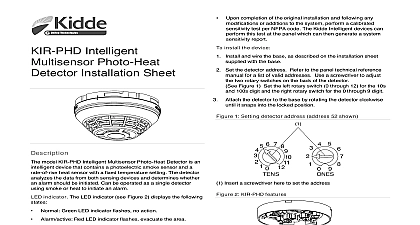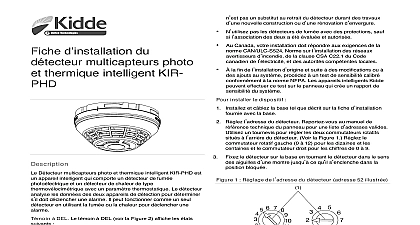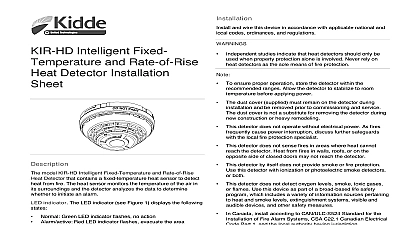Kidde 3102532-EN R001 KIR-PHCD Intelligent 3D Multisensor Photo-Heat-CO Detector Installation Sheet

File Preview
Click below to download for free
Click below to download for free
File Data
| Name | kidde-3102532-en-r001-kir-phcd-intelligent-3d-multisensor-photo-heat-co-detector-installation-sheet-0261895437.pdf |
|---|---|
| Type | |
| Size | 1005.35 KB |
| Downloads |
Text Preview
Intelligent Photo Heat CO Installation Sheet exposure Slight headache nausea vomiting fatigue runny nose eyes often described as symptoms Regulatory code may require that the system generate a three temporal code TC3 for fire alarms and a four pulse code TC4 for CO alarms The CO sensor is calibrated at the factory CO sensitivity is set to to UL 2034 requirements and cannot be changed by the See information on page 4 for specific sensitivity Connect this detector only to a UL Listed control panel capable of between alarm signals fire burglary CO etc and distinct identification for each To reduce the likelihood of nuisance alarms ventilate spaces when using household cleaning supplies similar contaminants If a detector has been exposed to such test it promptly afterwards of CO poisoning following symptoms related to CO poisoning should be discussed all occupants of the protected site exposure Severe throbbing headache dizziness drowsiness fast heart rate exposure Unconsciousness brain damage convulsions failure death cases of reported CO poisoning indicate that while victims are they are not well they become so disoriented that they are to save themselves by either exiting the building or calling for Young children and pets may be the first affected sources CO sensor in this detector is designed to detect carbon monoxide from any source of combustion It is not intended to detect fire or any other gas Potential CO sources include fuel fired e g space heater furnace water heater range oven dryer other sources of combustion e g kerosene burning or heater or gas log fireplace or internal combustion engines addition excessive exhaust spillage or reverse venting of fuel appliances can produce dangerous transient levels of CO This be caused by external conditions Wind direction velocity or a combination of both including high of wind or insufficient draft in vent pipes Temperature inversions that can trap exhaust gases near the Negative pressure differential resulting from the use of exhaust monoxide alarm procedure The carbon monoxide CO alarm indicates the presence CO which can kill you If the alarm signal sounds four times pauses five seconds and then repeats the pattern follow the steps shown Move to fresh air immediately outdoors or by an open door or Check that all persons are accounted for Do not reenter premises or move away from the open door or window until services responders have arrived the premises have aired out and your detector remains in normal condition Call emergency services the fire department or 911 about carbon monoxide Read these installation instructions in their entirety before Leave these instructions with the owner user of this detection equipment This product is intended for use in indoor locations of dwelling It is not designed to comply with Occupational Safety and Administration OSHA commercial or industrial standards The detector only indicates the presence of CO gas at the Carbon monoxide gas may be present in other areas Simultaneous operation of several fuel burning appliances for limited internal air Failure to properly install test and maintain a CO detector may it to fail potentially resulting in loss of life Vent pipe connections vibrating loose from dryers furnaces or heaters of this detector is not a substitute for proper installation and maintenance of fossil fuel burning appliances including ventilation and exhaust systems To reduce the risk of CO poisoning test the detector operation not in use for 10 days or more This detector does not operate without electrical power As fires cause power interruption discuss further safeguards the authority having jurisdiction AHJ Obstructions in vent pipes or unconventional vent pipe designs can amplify the above situations Poorly designed or maintained chimneys and or vents Extended operation of unvented fossil fuel burning devices range fireplace etc cars in an open or closed attached garage or near the Do not paint the detector 2018 United Technologies Corporation 4 3102532 EN REV 001 ISS 16OCT18 Within 5 ft 1.5 m of any cooking appliance Within 10 ft 3 m of a fuel burning appliance Near air conditioners heating registers or any other ventilation that may interfere with CO gas entering the detector Where furniture or draperies may obstruct the airflow a recessed area 1 Recommended CO detector locations limitations of CO detectors not install the CO detector detector is designed to protect individuals from the acute affects CO exposure It will not fully safeguard individuals with specific conditions People with special medical problems should using specialized detection devices with less than 30 ppm per million alarming capabilities If in doubt consult a medical the detector is in trouble or at the end of its life it may not sense CO cannot be relied upon to monitor CO levels Replace the detector ten years from the date of manufacture or when the control panel a sensor end of life condition whichever comes first detector installed outside a bedroom may not awaken a sleeper noise due to stereos television etc may also prevent the from being heard if distance or closed or partly closed doors the sounder This unit is not designed for the hearing impaired detectors are not a substitute for life safety Though these will warn against increasing CO levels we do not warrant or in any way that they will protect lives from CO poisoning They only be considered as an integral part of a comprehensive program locations a suitable location is critical to the operation of CO detectors 1 shows appropriate detector locations detectors according to applicable codes and standards Place detectors at least 5 ft 1.5 m up from the floor For mounted applications place detectors at least 1 ft 0.3 m from wall For combination detectors follow the spacing requirements each sensor Refer to the control panel application bulletin for the spacing requirements Recommended CO detector location recommended CO detector locations are Outside each separate sleeping area in the immediate vicinity of bedrooms including areas such as hotel rooms and dorm On every occupiable level of a dwelling unit including basements excluding attics and crawl spaces Centrally located on every habitable level of the building and in HVAC zone based on an engineering evaluation considering sources and migration of carbon monoxide model KIR PHCD Intelligent Multisensor Photo Heat CO Detector an intelligent analog device that contains a photoelectric smoke a rate of rise heat sensor and a carbon monoxide sensor to carbon monoxide gas from sources of combustion The detector the smoke and heat sensors independently from the CO to determine whether to initiate a fire alarm a life safety CO or both indicator The LED indicator see Figure 2 displays the following Normal Green LED indicator flashes no action Alarm active Red LED indicator flashes evacuate the area On the ceiling in the same room as permanently installed fuel end of life indicator appliances any area required by local building codes legislation or the AHJ a suitable environment per the detector specifications see on page 4 for details On a firm permanent surface detector signals a TRBL ACT condition on the control when the CO sensor reaches its end of life Pressing the Details on the control panel displays OF LIFE ACT providing that it is an end of life trouble of the CO sensor This remains active until the detector is replaced even if the panel is 2 KIR PHCD features 4 3102532 EN REV 001 ISS 16OCT18


